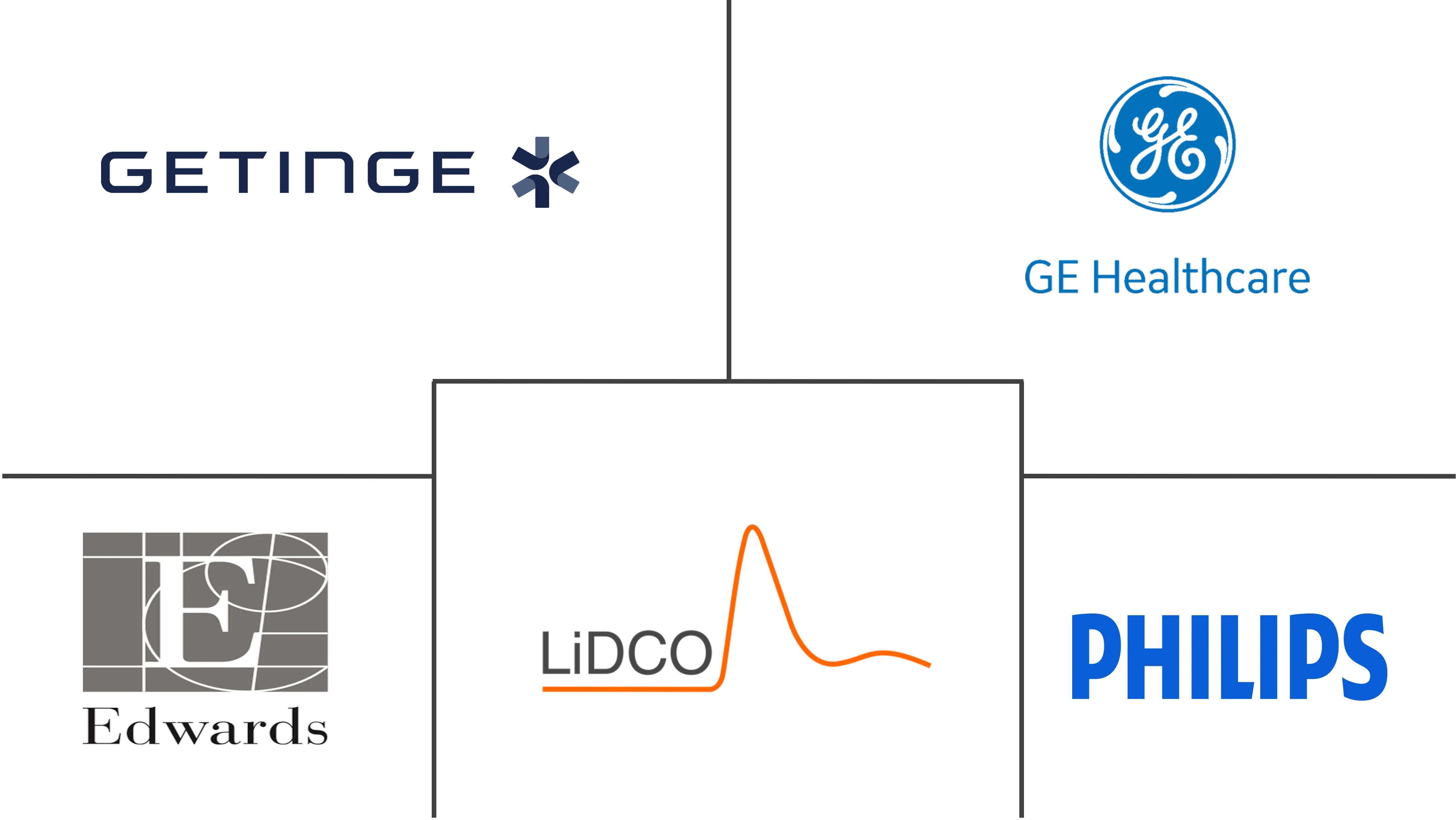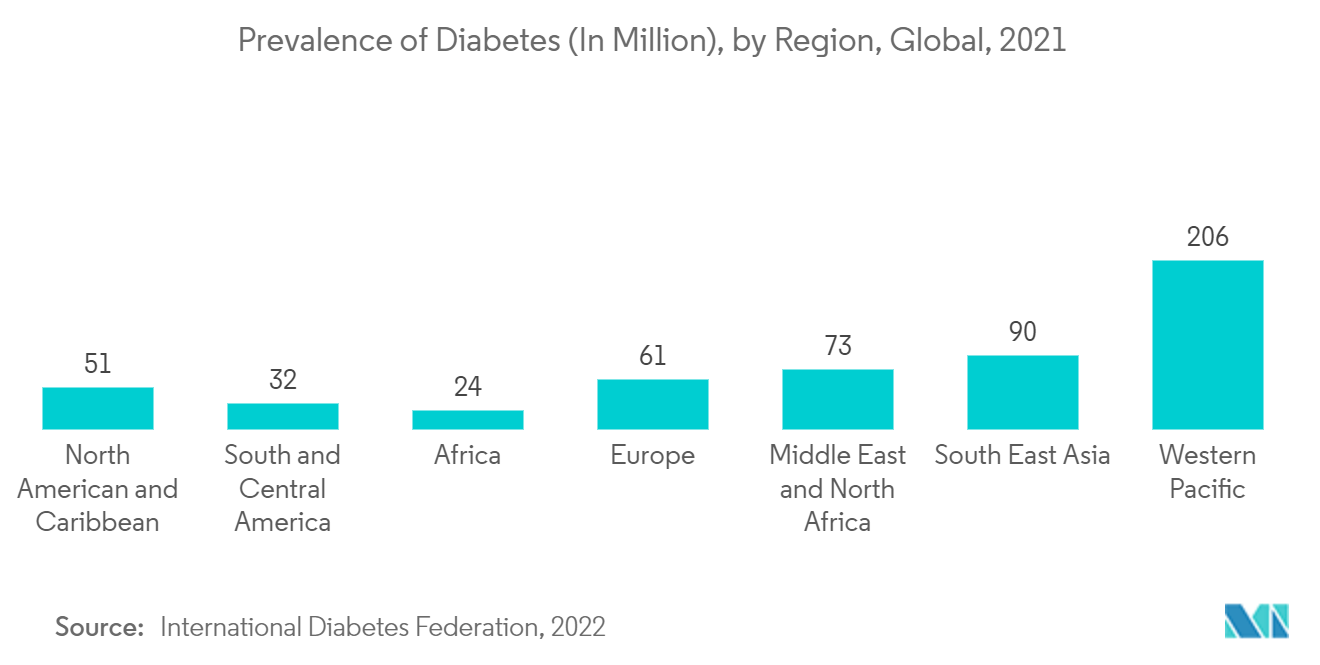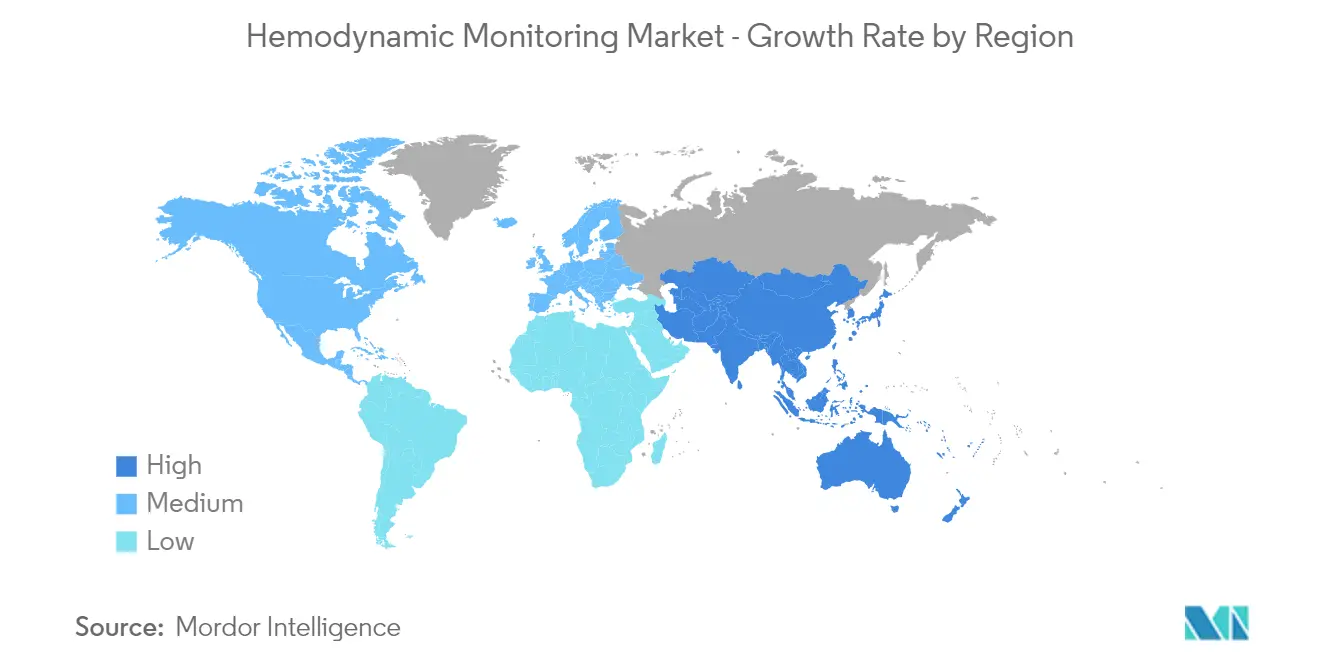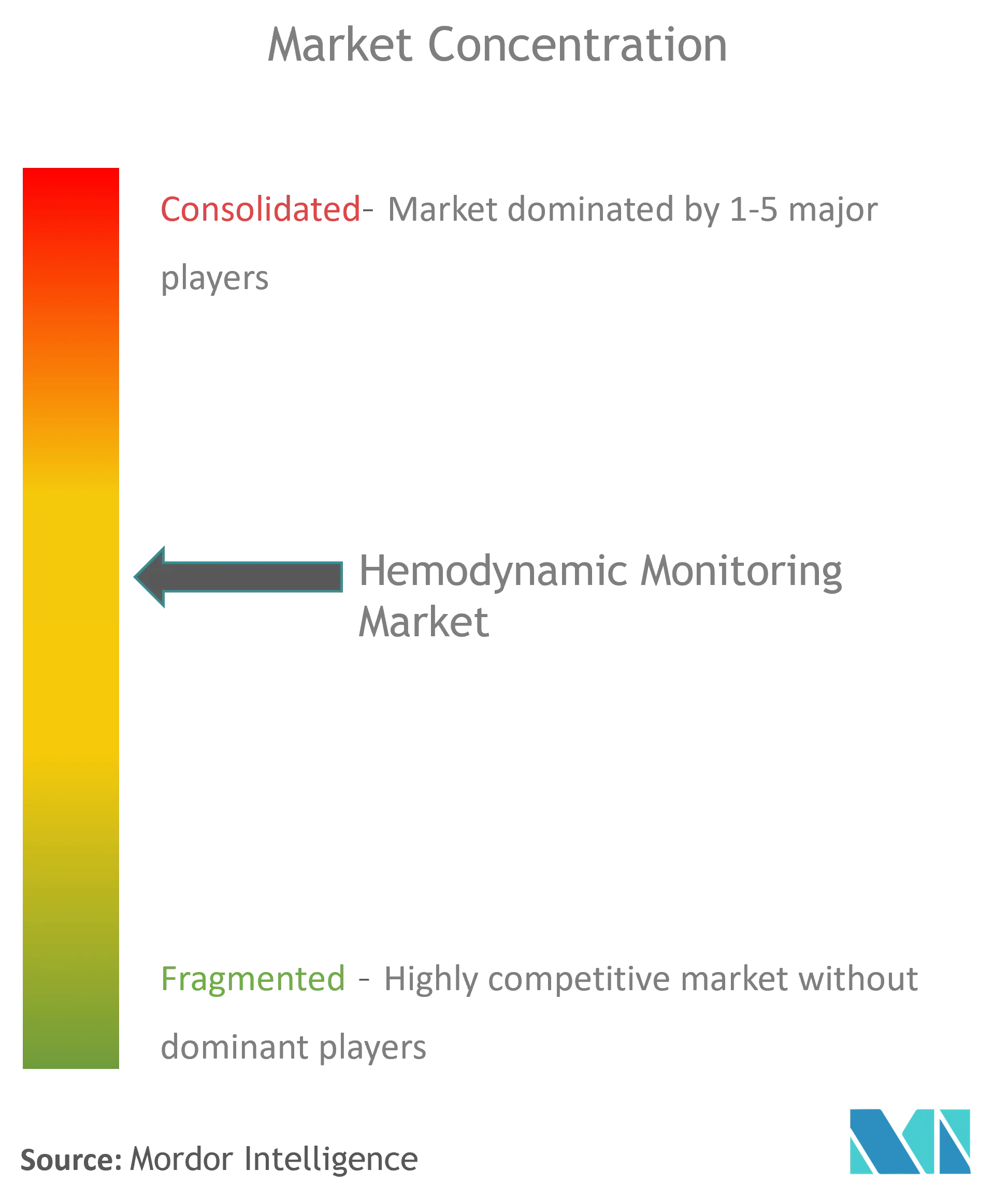Hemodynamic Monitoring Devices Market Size

| Study Period | 2019 - 2029 |
| Market Size (2024) | USD 1.24 Billion |
| Market Size (2029) | USD 1.48 Billion |
| CAGR (2024 - 2029) | 3.58 % |
| Fastest Growing Market | Asia Pacific |
| Largest Market | North America |
Major Players
*Disclaimer: Major Players sorted in no particular order |
Hemodynamic Monitoring Devices Market Analysis
The Global Hemodynamic Monitoring Market size is estimated at USD 1.24 billion in 2024, and is expected to reach USD 1.48 billion by 2029, growing at a CAGR of 3.58% during the forecast period (2024-2029).
COVID-19 has a substantial market impact. According to the LiDCO Group PLC's annual report for 2020, demand for hemodynamic monitoring equipment has increased from many existing customers, with significant short-term heightened demand from UK hospitals and increased demand in several other countries, including a small number of monitors sold in Wuhan, China. Furthermore, some COVID-19 patients develop complications such as sepsis and require intensive care, and there is strong clinical evidence that using advanced hemodynamic monitoring improves patient outcomes. Hence, this is also likely to create more demand for the products till the pandemic ends.
The key factors propelling the growth of this market are an increase in the number of critically ill geriatric cases, a rise in the prevalence of cardiac disorders and diabetes, increasing demand for home-based and non-invasive monitoring systems, and an increase in the number of people suffering from hypertension. As per the World Health Organization's Fact of 2021, an estimated 1.28 billion adults aged 30-79 years worldwide have hypertension. As per the same source, Cardiovascular diseases (CVDs) are the leading cause of death globally, taking an estimated 17.9 million lives each year, an estimated 32% of all the deaths worldwide. Hence the prevalence of cardiac disorders and hypertension will likely boost the market growth.
New techniques of hemodynamic monitoring have the potential to advance the management of the cardiovascular patient during postoperative care and anesthesia as they provide accurate and repeatable measurements that can be used to detect hemodynamic alterations and their causes, optimize hemodynamic conditions such as oxygen delivery to the tissues, and provide feedback on the adequacy of therapeutic interventions. The transition from static to dynamic variables to assess requirements such as cardiac preload and fluid responsiveness, as well as the change to less invasive or noninvasive monitoring techniques, are also driving the market growth.
Thus, the market is expected to show growth over the forecast period. However, Increasing incidences of complications associated with an invasive monitoring system and stringent FDA guidelines for approval of new systems may hinder the growth of the market.
Hemodynamic Monitoring Devices Market Trends
This section covers the major market trends shaping the Hemodynamic Monitoring Market according to our research experts:
Minimally Invasive Monitoring Systems is Expected to Hold High Market Share Over the Forecast Period
In the system segment of the market, minimally invasive monitoring systems are believed to have the largest market size and are expected to witness significant growth during the forecast period.
The minimally invasive systems help track stroke volume continuously and offer dynamic information on fluid responsiveness. Some systems assess volumetric preload variables, while others highlight the continuous measurement of central venous saturation with proprietary catheters. These variables of minimally invasive procedures and cardiac output deliver improved hemodynamic monitoring.
There is a recent advancement in echocardiography devices known as a transesophageal echocardiography device with a miniaturized probe, which is now used for continuous hemodynamic assessment. These monitoring systems have made hemodynamic calculations easier, gaining healthcare providers' attention, thus, resulting in the market's growth. Additionally, the market players for reaching out large population base are timely participating in various health conferences. For Instance, in January 2022, At Arab Health 2022, Masimo demonstrated how different solutions from the company can work together across the patient journey - from the hospital to the home and anywhere care is provided - to help care teams enhance care consistency and improve patient outcomes. The company shoed its non-invasive monitoring solutions.
Thus, owing to the abovementioned factors, the market segment is expected to show growth over the forecast period.

North America Dominates the Market and Expected to do the Same Over the Forecast Period
North America currently dominates the market for hemodynamic monitoring and is expected to continue its stronghold for a few more years. The United States holds the largest share of the global hemodynamic monitoring market. The growth of the United States hemodynamic monitoring market is the most notable, owing to significant market players, technologically advanced hospitals, and an increasing number of critically ill patients being treated in the region's hospitals.
According to Edwards Lifesciences Corporation's annual report, demand for its pressure monitoring products increased in the United States in 2020, and this trend continued through the fourth quarter. In 2021, as hospital capital spending continued to improve and COVID hospitalizations in the United States increased, there was an increase in demand for pressure monitoring.
Moreover, with increasing United States Food and Drug Administration (FDA) approvals for monitoring devices and new product launches in the United States hemodynamic monitoring market is expected to grow during the forecast period. For instance, in September 2021, Caretaker Medical landed FDA clearance for its blood pressure and hemodynamic patient monitoring system VitalStream. Also, in March 2021, Fifth Eye, a Michigan-based real-time clinical analytics company, announced that the Food and Drug Administration had granted DE Novo classification for its Analytic for Hemodynamic Instability (AHI) tool.
Thus, owing to the abovementioned factors, the market in the North American region is expected to show growth over the forecast period.

Hemodynamic Monitoring Devices Industry Overview
The hemodynamic monitoring market is highly competitive and consists of several major players. In terms of market share, few significant players currently dominate the market. However, with technological advancements and product innovations, mid-size to smaller companies are increasing their market presence by introducing new devices with fewer prices. Companies like Getinge Group, Koninklijke Philips NV, Edwards Life Sciences Corporation, GE Healthcare, and LiDCO Group hold substantial shares in the market.
Hemodynamic Monitoring Devices Market Leaders
-
Koninklijke Philips NV
-
Edwards Lifesciences Corporation
-
LiDCO Group PLC
-
Getinge AB
-
GE Healthcare
*Disclaimer: Major Players sorted in no particular order

Hemodynamic Monitoring Devices Market News
- In February 2022, Noninvasix announced that its LIVOx Central Venous Oxygenation Monitor had received Breakthrough Device Designation from the U.S. Food and Drug Administration (FDA) for non-invasive, real-time, continuous, or spot monitoring of central venous oxygen saturation (ScvO2) in adults at risk of septic shock.
- In January 2022, Sensydia, an innovator in the rapid, non-invasive measurement of critical cardiac function, announced that its Cardia Performance System (CPSTM) had been granted Breakthrough Device Designation by the United States Food and Drug Administration (FDA).
Hemodynamic Monitoring Devices Market Report - Table of Contents
1. INTRODUCTION
- 1.1 Study Assumptions and Market Definition
- 1.2 Scope of the Study
2. RESEARCH METHODOLOGY
3. EXECUTIVE SUMMARY
4. MARKET DYNAMICS
- 4.1 Market Overview
-
4.2 Market Drivers
- 4.2.1 Increasing Critically Ill Geriatric Population
- 4.2.2 Rise in the Prevalence of Cardiac Disorders and Diabetes
- 4.2.3 Technological Advanements
-
4.3 Market Restraints
- 4.3.1 Increasing Incidences of Complications Associated with Invasive Monitoring Systems
- 4.3.2 Stringent FDA Guidelines for Approval of New Systems
-
4.4 Porter's Five Forces Analysis
- 4.4.1 Threat of New Entrants
- 4.4.2 Bargaining Power of Buyers/Consumers
- 4.4.3 Bargaining Power of Suppliers
- 4.4.4 Threat of Substitute Products
- 4.4.5 Intensity of Competitive Rivalry
5. MARKET SEGMENTATION (Market Size by Value - USD million)
-
5.1 By System
- 5.1.1 Minimally Invasive Monitoring Systems
- 5.1.2 Invasive Monitoring Systems
- 5.1.3 Non-invasive Monitoring Systems
-
5.2 By Application
- 5.2.1 Laboratory-based Monitoring Systems
- 5.2.2 Home-based Monitoring Systems
- 5.2.3 Hospital-based Monitoring Systems
-
5.3 Geography
- 5.3.1 North America
- 5.3.1.1 United States
- 5.3.1.2 Canada
- 5.3.1.3 Mexico
- 5.3.2 Europe
- 5.3.2.1 Germany
- 5.3.2.2 United Kingdom
- 5.3.2.3 France
- 5.3.2.4 Italy
- 5.3.2.5 Spain
- 5.3.2.6 Rest of Europe
- 5.3.3 Asia-Pacific
- 5.3.3.1 China
- 5.3.3.2 Japan
- 5.3.3.3 India
- 5.3.3.4 Australia
- 5.3.3.5 South Korea
- 5.3.3.6 Rest of Asia-Pacific
- 5.3.4 Middle East and Africa
- 5.3.4.1 GCC
- 5.3.4.2 South Africa
- 5.3.4.3 Rest of Middle-East and Africa
- 5.3.5 South America
- 5.3.5.1 Brazil
- 5.3.5.2 Argentina
- 5.3.5.3 Rest of South America
6. COMPETITIVE LANDSCAPE
-
6.1 Company Profiles
- 6.1.1 LiDCO Group PLC
- 6.1.2 Baxter (Cheetah Medical Inc.)
- 6.1.3 ICU Medical Inc.
- 6.1.4 Tensys Medical Inc.
- 6.1.5 Schwarzer Cardiotek GmbH
- 6.1.6 Koninklijke Philips NV
- 6.1.7 Edwards Lifesciences Corporation
- 6.1.8 Getinge Group
- 6.1.9 GE Healthcare
- 6.1.10 Draeger Medical
- 6.1.11 Masimo
- 6.1.12 Smiths Medical
- 6.1.13 Change Healthcare
- 6.1.14 Deltex Medical, SC
- *List Not Exhaustive
7. MARKET OPPORTUNITIES AND FUTURE TRENDS
** Subject To AvailablityHemodynamic Monitoring Devices Industry Segmentation
As per the report's scope, critically ill patients require continuous monitoring of their vital parameters. This is done by direct pressure monitoring systems, also known as hemodynamic systems. The primary function of these systems is to monitor cardiac activity. The hemodynamic systems give blood pressure, volume, and fluid balance information. The Hemodynamic Monitoring Market is Segmented by System (Minimally Invasive Monitoring Systems, Invasive Monitoring Systems, and Non-invasive Monitoring Systems), Application (Laboratory-based Monitoring Systems, Home-based Monitoring Systems, Hospital-based Monitoring Systems), and, Geography (North America, Europe, Asia-Pacific, Middle East, and Africa, and South America). The market report also covers the estimated market sizes and trends for 17 countries across major global regions. The report offers the value (USD million) for the above segments.
| By System | Minimally Invasive Monitoring Systems | |
| Invasive Monitoring Systems | ||
| Non-invasive Monitoring Systems | ||
| By Application | Laboratory-based Monitoring Systems | |
| Home-based Monitoring Systems | ||
| Hospital-based Monitoring Systems | ||
| Geography | North America | United States |
| Canada | ||
| Mexico | ||
| Geography | Europe | Germany |
| United Kingdom | ||
| France | ||
| Italy | ||
| Spain | ||
| Rest of Europe | ||
| Geography | Asia-Pacific | China |
| Japan | ||
| India | ||
| Australia | ||
| South Korea | ||
| Rest of Asia-Pacific | ||
| Geography | Middle East and Africa | GCC |
| South Africa | ||
| Rest of Middle-East and Africa | ||
| Geography | South America | Brazil |
| Argentina | ||
| Rest of South America |
Hemodynamic Monitoring Devices Market Research FAQs
How big is the Global Hemodynamic Monitoring Market?
The Global Hemodynamic Monitoring Market size is expected to reach USD 1.24 billion in 2024 and grow at a CAGR of 3.58% to reach USD 1.48 billion by 2029.
What is the current Global Hemodynamic Monitoring Market size?
In 2024, the Global Hemodynamic Monitoring Market size is expected to reach USD 1.24 billion.
Who are the key players in Global Hemodynamic Monitoring Market?
Koninklijke Philips NV, Edwards Lifesciences Corporation, LiDCO Group PLC, Getinge AB and GE Healthcare are the major companies operating in the Global Hemodynamic Monitoring Market.
Which is the fastest growing region in Global Hemodynamic Monitoring Market?
Asia Pacific is estimated to grow at the highest CAGR over the forecast period (2024-2029).
Which region has the biggest share in Global Hemodynamic Monitoring Market?
In 2024, the North America accounts for the largest market share in Global Hemodynamic Monitoring Market.
What years does this Global Hemodynamic Monitoring Market cover, and what was the market size in 2023?
In 2023, the Global Hemodynamic Monitoring Market size was estimated at USD 1.20 billion. The report covers the Global Hemodynamic Monitoring Market historical market size for years: 2019, 2020, 2021, 2022 and 2023. The report also forecasts the Global Hemodynamic Monitoring Market size for years: 2024, 2025, 2026, 2027, 2028 and 2029.
Hemodynamic Monitoring Devices Industry Report
Statistics for the 2024 Hemodynamic Monitoring Devices market share, size and revenue growth rate, created by Mordor Intelligence™ Industry Reports. Hemodynamic Monitoring Devices analysis includes a market forecast outlook to 2029 and historical overview. Get a sample of this industry analysis as a free report PDF download.



